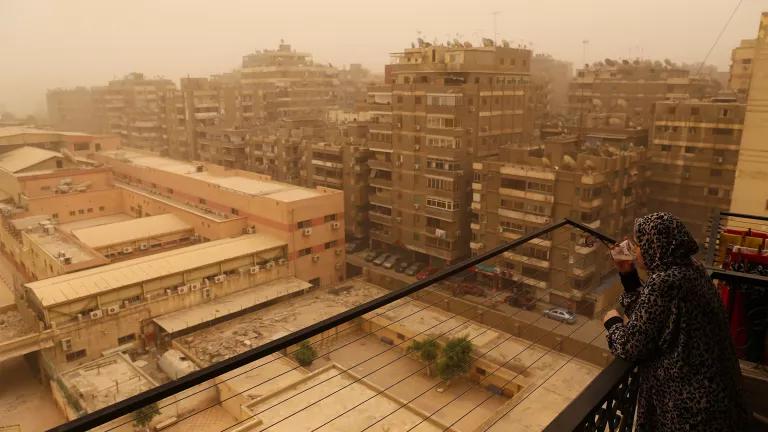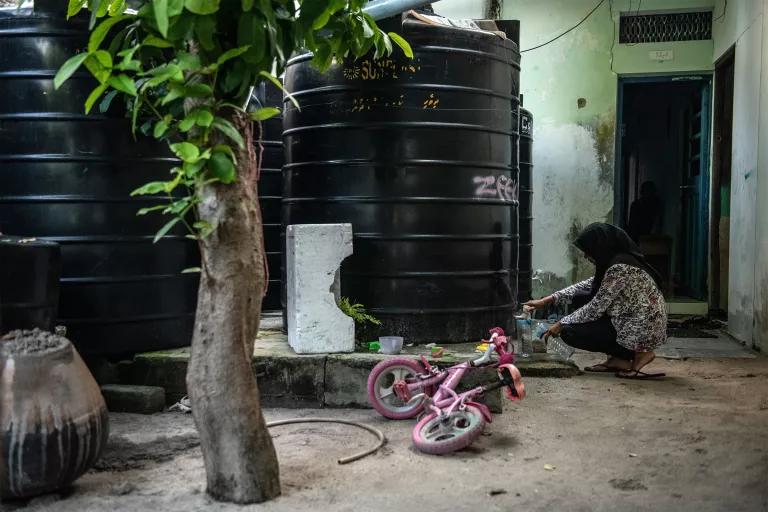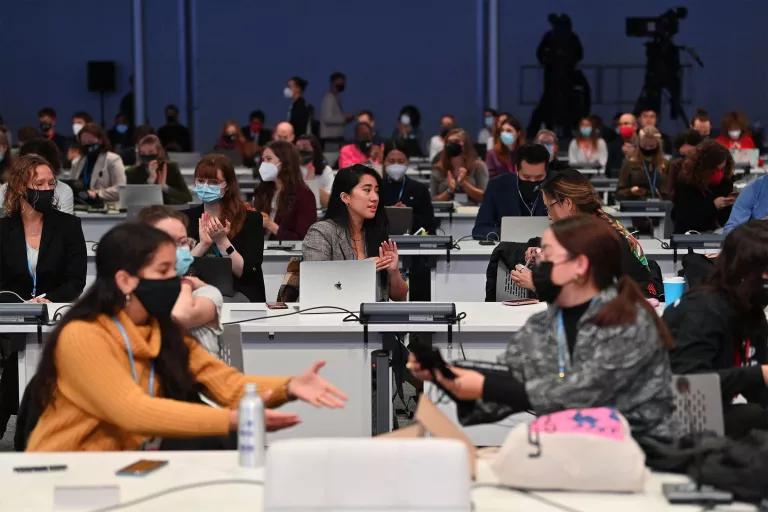COP27: The Issues, the Tensions, and the Urgent Need for Unity on Climate
Here’s what to expect from the upcoming international climate change summit in Egypt.

Sandstorms, like this one in Cairo, Egypt, are worsening due to climate change.
What is COP27?
The past seven years have been the warmest on record. For a brief period, worldwide lockdowns caused greenhouse gas emissions to drop, but rates have since risen to pre-pandemic levels. The stakes couldn’t be higher for the 2022 Conference of the Parties summit (COP27) of the United Nations Framework Convention on Climate Change. A few weeks from now in Sharm El-Sheikh, a resort town on Egypt’s eastern coast, representatives from nearly 200 countries—including more than 100 heads of state—will join business leaders, religious figures, climate experts, local officials, and advocates for 12 days of events and official negotiations. The goal is to strengthen and hasten the international response to the climate crisis that continues to wreak havoc across the globe.
This moment in COP history
The earliest COP gatherings (the first conference took place in 1995) focused mainly on mitigation: getting countries to commit to reducing their greenhouse gas emissions in order to avoid the worst impacts of the climate crisis that scientists had warned us was coming. But everyone who attends COP gatherings these days recognizes that curbing carbon pollution is only a part of the solution. Since climate change is already here—and accelerating—we must also be developing new strategies for adapting to intensifying droughts, wildfires, tropical storms, and floods.
And as we pursue these strategies, equity must be top of mind. The United States, China, Russia, and members of the European Union have together emitted 63 percent of the carbon pollution in the atmosphere, while the 10 most climate-vulnerable nations are collectively responsible for about 1 percent. As NRDC President Manish Bapna recently put it, wealthier, high-emitting nations can neither expect nor allow poorer, low-emitting nations to keep “paying a price they can’t afford for a climate crisis they didn’t cause.”
These are the big issues confronting attendees of COP27, which will focus on four broad themes: mitigation, adaptation, finance, and collaboration.
Mitigation
Seven months ago, the Intergovernmental Panel on Climate Change (IPCC) released a major report that re-emphasized the urgency of limiting global warming to no more than 1.5 degrees Celsius above pre-industrial levels in order to avoid the climate-related consequences that are even more frequent and intense than the disasters the world is already currently experiencing. Just a temperature rise of 1.5 degrees Celsius, its authors wrote, will likely cause "unavoidable increases in multiple climate hazards and present multiple risks to ecosystems and humans." Such risks include the extinction of plant and animal species that are unable to adapt to shifts in climate and the mass migration of people whose lands have become uninhabitable, or whose livelihoods are destabilized.
We’re moving in the wrong direction. Right now, even if every nation on earth were to meet its publicly stated climate goals, we would still see a global temperature rise of between 2.4 and 2.7 degrees Celsius. Or to put it another way: Our individual climate targets, at the moment, don’t add up to collective success. Expect discussions of mitigation at COP27 to focus on cementing plans to close this glaring gap. (Also expect to hear renewed complaints that a last-minute edit to the Glasgow Climate Pact, the main document produced last year at COP26, resulted in the declaration that countries should be striving to “phase down”—rather than “phase out”—coal combustion, which was responsible for releasing nearly 14 billion metric tons of carbon dioxide in 2020. That’s more than five times the amount generated collectively over the course of a year by every gas-powered passenger vehicle in the world.)
Adaptation
Adaptation proved to be a volatile subject last year, as representatives from some of the world’s most climate-vulnerable countries relayed—often in stark and sobering terms—the devastating impacts that climate change is having on their communities and landscapes, especially in places like the Pacific Islands. “Our islands are slowly being eaten by the sea, one by one,” Maldives President Ibrahim Mohamed Solih told his fellow attendees. “If we do not reverse this trend, the Maldives will cease to exist by the end of the century.”

The anger and frustration expressed by some nations, many of them from the Global South, over the disproportionate climate impacts that they are forced to bear was compounded by the sense that their voices were being minimized or even silenced in the larger discussion over how to design and implement adaptation strategies. These same tensions may well erupt again this year, unless wealthy countries are able to show that they’re willing to do more than opine on the severity of the problem—in short, to put their money where their mouth is. As Teresa Anderson of the antipoverty advocacy group ActionAid International put it at the conclusion of COP26: “Frontline countries will not let this issue rest. We need an outcome that shows communities hit hardest by the climate crisis that the whole world is in this together.”
Finance
By far, the biggest criticism leveled at COP has been its failures around funding—specifically, the annual $100 billion through 2020 that developing nations were promised back in 2009 for reducing greenhouse gas emissions and adapting to the impacts of climate change. The money, which was to be mobilized by the world’s richest nations, had symbolic as well as material value: It was seen as a long-overdue acknowledgement that wealthy high-emitters bear a moral responsibility to alleviate the climate burden of their less-wealthy, less-polluting neighbors, and it provides critical public investments to accelerate the transition to clean energy and adapt to the mounting challenges of the climate crisis.
This finance promise that was made in 2009, and reiterated in the 2015 Paris Agreement, has not been honored, however. Wealthy nations have consistently fallen short of meeting this funding commitment; in 2020, they mobilized only $83 billion out of the $100 billion promised. Part of the problem is that the nations never agreed on how to split the bill. A variety of studies have suggested different ways to divvy up the sum, such as in proportion to each country’s wealth, greenhouse gas emissions, or population. The common finding across these analyses is that the United States has the biggest shortfall between what it ought to be contributing and what it has contributed, to the tune of tens of billions of dollars a year.
But as noted at COP26, had these nations contributed the full $100 billion each year, it still wouldn’t be enough to address the challenges faced by climate-vulnerable countries. The U.N. Environment Programme estimates that adaptation costs alone in developing countries could reach as high as $300 billion per year by 2030. Last year, new promises were made to meet the original $100 billion-per-year target…but not until 2023. Meanwhile, governments are negotiating a new climate finance goal beyond the $100 billion for the post-2025 period. We can expect more tense discussions around the need to dramatically scale up climate financing this year.
Also certain to be discussed intensely and at length: the need for wealthy, developed countries to acknowledge—and pay for—climate loss and damage that has already occurred in late-industrializing and developing countries. For many years, the topic has been woven into the broader conversation about climate financing, but this year, there's strong momentum to see loss and damage added to the formal COP agenda. More than 400 different organizations have called for just that; it's difficult to see how organizers can ignore the weight of their collective and well-publicized effort.

Collaboration
Every year, COP participants and non-participants alike say that this year’s COP is the most important one to date, the one where we absolutely must unite over our common cause…and every year, as it happens, they’re correct. But tension—between the Global North and the Global South, between countries seeking to move away from fossil fuels and countries that are either unprepared or unwilling to do so—has been an element of practically every COP gathering. It will be an element of this one as well. (The war in Ukraine and the related disruption of international energy markets haven’t exactly fostered global unity, either.)
In an effort to plant the seeds of collaboration in advance of the actual summit, the Democratic Republic of Congo hosted a pre-summit in early October that was attended virtually or in person by delegates from more than 50 countries. Citing recent climate-related calamities in Pakistan, Europe, Cuba, the Philippines, and the United States, U.N. Secretary-General António Guterres emphasized the global aspect of climate change, calling for a "quantum level compromise" between nations. But statements made by Congolese Deputy Prime Minister Eve Bazaiba on the eve of the event hinted at the tone we can expect come November. Noting that the world’s 20 wealthiest countries are responsible for 80 percent of global emissions, she plainspokenly predicted that "unless a global effort is made…no one will escape. We all breathe the same air."
How collaboration gets defined—and especially who gets to define it—is clearly on the minds of everyone going into COP27. If any significant progress is to be made there on mitigation, adaptation, or finance, attendees must address these tensions forthrightly and transparently. It will no longer suffice for high-emitting nations to steer the international discussion. With any luck, these nations have learned that lesson over the past several years, and now understand that real climate progress won’t occur until everyone has a place at the negotiating table.
This NRDC.org story is available for online republication by news media outlets or nonprofits under these conditions: The writer(s) must be credited with a byline; you must note prominently that the story was originally published by NRDC.org and link to the original; the story cannot be edited (beyond simple things such as grammar); you can’t resell the story in any form or grant republishing rights to other outlets; you can’t republish our material wholesale or automatically—you need to select stories individually; you can’t republish the photos or graphics on our site without specific permission; you should drop us a note to let us know when you’ve used one of our stories.

When Customers and Investors Demand Corporate Sustainability
What Are the Effects of Climate Change?
There’s Actually Some Good News in That Scary IPCC Report
When Customers and Investors Demand Corporate Sustainability
What Are the Effects of Climate Change?
There’s Actually Some Good News in That Scary IPCC Report
When Customers and Investors Demand Corporate Sustainability
What Are the Effects of Climate Change?
There’s Actually Some Good News in That Scary IPCC Report
When Customers and Investors Demand Corporate Sustainability
What Are the Effects of Climate Change?